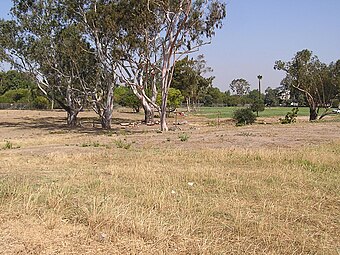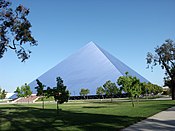Puvunga
Puvunga Indian Village Sites and Boundary Increase | |
 The Puvunga site on the campus of Cal State Long Beach | |
| Nearest city | Long Beach, California |
|---|---|
| Coordinates | 33°47′06″N 118°07′16″W / 33.785°N 118.121°WCoordinates: 33°47′06″N 118°07′16″W / 33.785°N 118.121°W |
| Architect | Tongva |
| NRHP reference No. | 74000521 (original) 82000429 (increase) |
| Significant dates | |
| Added to NRHP | January 21, 1974 |
| Boundary increase | May 22, 1982 |
Puvunga (alternate spellings: Puvungna or Povuu'nga) is an ancient village and sacred site of the Tongva nation, who are the indigenous people of the region around Los Angeles, California, and the Acjachemen who are the indigenous people of Orange County.[1] The Tongva referred to Puvunga as the "place of emergence" and it is where they believed "their world and their lives began."[2]
Puvunga is believed to be the birthplace of Chingishnish in Tongva mythology, "the prophet or deity who appears at Puvunga after Wiyot, the creator, has been killed, and tells the assembly what they must do in order to feed themselves."[3] Anthropologists theorize that Chingichngish was “a messianic leader who played the dominant role in the Shoshonean invasion and settlement of the coastal strip” we now associate with the Tongva.[4]
The site is located near the Earl Burns Miller Japanese Garden on the campus of present-day California State University, Long Beach along the banks of a now channelized creek, about three miles (5 km) from the Pacific Ocean. A portion of the site (which is not marked with a sign or other informational marker) comprises a natural area located at the edge of campus, near a parking lot. At one time this site had a natural spring, and the location is sometimes referred to as Puvunga Spring. Another similar (but larger) Tongva site is Kuruvungna Springs on the grounds of University High School in Los Angeles.
History
Archeologists working the site in 1974 found that the Tongva “abruptly abandoned the site in the early 1800s, only a year or so before the first white family took possession of the land.”[4]
Since the 1960s the Tongva people have sought to preserve the Puvunga site from development, and it was listed on the National Register of Historic Places in 1974.[5]
However, the university has challenged this designation, claiming they were not consulted when the application was filed. More than a dozen archaeological sites spread over an area of about 500 acres (2.0 km2) on and near the campus have been identified as Puvungna village sites. A shopping center and apartments at 7th Street and Pacific Coast Highway, Long Beach Veterans Administration Hospital, Rancho Los Alamitos and the college now stand atop the historic settlement “near the present-day mouth of the San Gabriel River and the Cerritos Channel.”[4]
In 1972, campus workmen uncovered portions of an Indian burial on one of these sites, LAn-235, located on the western edge of campus. Funding for the 1973 excavation was provided by the City of Long Beach, Long Beach Historical Society, Rancho Los Alamitos Associates, and private donors.[4] Tongva remnants unearthed included arrowheads and shards of pottery in a style called Cerritos brown ware.[4] These remains were placed in CSULB's archaeology lab.
A few years later, LAn-235 was placed on the National Register of Historic Places to "represent" Puvungna "as a means of perpetuating the memory of these native peoples and their religion, and as an aid to the program of public education." Two other sites were included in the National Register: the adjacent LAn-234 and LAn-306, located just east of campus on the grounds of the historic Rancho Los Alamitos.[citation needed]
In 1992, when the university began its first attempts to build a strip mall on this last undeveloped portion of the campus, the Tongva people initiated protests and filed a lawsuit which temporarily stalled any construction. The site remains as an undeveloped grassy area with a few trees.[6]
In 2019, CSULB received backlash after dumping dirt and trash on the site.[7] Local Indigenous groups, such as the Juaneño Band of Mission Indians, Acjachemen Nation-Belardes tribe were not consulted in regard to the dumping. This resulted in a legal challenge by the tribe which halted the dumping in October 2019. However, the legal proceedings were stalled as a result of the COVID-19 pandemic and CSULB had yet to remove the dirt and trash by May 2020. Chairman of the tribe Matias Belardes commented on how the dumping reflected a shift in attitude from the university since the 1992 lawsuit:[6]
We’ve had a decent relationship since then [the 1992 incident when CSULB attempted to build a strip mall on the site] ... [We] find it disrespectful and disheartening. Ever since that lawsuit, it was thought that there would be a better understanding of what that site means to us. Somewhere along the way there’s been a disconnect. Now we’re back to square one after all these positive things that have come from the original lawsuit all those years ago. We thought we were past it already. It shouldn’t have come to this. The university should know the significance of the site, what it means to the tribes and what you can and can’t do on the property.[6]
External links
- The California Cultural Resources Preservation Alliance Inc. (CCRPA)
- Puvungna web page maintained by Prof. Eugene Ruyle
- CSULB 49er article on Puvunga (February 2006)
See also
References
- ^ Boscana, 1846 - Chinigchinich – A Historical Account of the Origin, Customs, and Traditions of the Indians at the Missionary Establishment of St. Juan Capistrano, Alta California Called the Acagchemem Nation
- ^ Greene, Sean; Curwen, Thomas (9 May 2019). "Mapping the Tongva villages of L.A.'s past". LA Times. Retrieved 19 June 2019.
- ^ Loewe, Ronald (2016). Of Sacred Lands and Strip Malls: The Battle for Puvungna. Rowman & Littlefield. p. 26. ISBN 9780759121607.
- ^ a b c d e Getze, Goerge. "PUVUNGNA PARTIALLY EXCAVATED: INDIAN HOLY VILLAGE UNCOVERED ARCHAEOLOGISTS BEGIN DIG ON INDIAN VILLAGE." Los Angeles Times (1923-1995), Apr 08, 1974, pp. 2-oc_a1.
- ^ "National Register of Historical Places - CALIFORNIA (CA), Los Angeles County". www.nationalregisterofhistoricplaces.com. Retrieved 2022-08-17.
- ^ a b c Kazenoff, Tess; Gomez, Savannah (25 May 2020). "CSULB dumping on Native American burial site". Long Beach City College Viking News.
- ^ Jordan, Rachel (5 October 2019). "CSULB under fire for dumping dirt, trash on sacred Native American grounds". abc7.
- Articles with short description
- Coordinates not on Wikidata
- NRHP infobox with nocat
- All articles with unsourced statements
- Articles with unsourced statements from October 2008
- AC with 0 elements
- Tongva
- Tongva populated places
- Archaeological sites in California
- California State University, Long Beach
- Historic districts on the National Register of Historic Places in California
- History of Long Beach, California
- History of Los Angeles County, California
- Religious places of the indigenous peoples of North America
- Properties of religious function on the National Register of Historic Places in California
- National Register of Historic Places in Los Angeles County, California
- Populated places on the National Register of Historic Places in California





